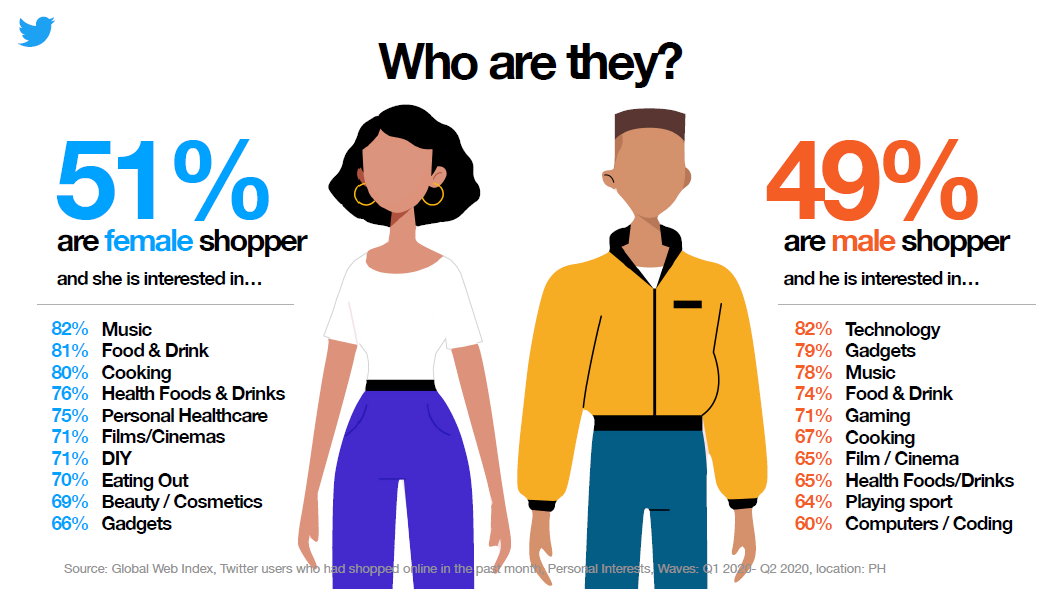What Pinoys bought online during the quarantine and after
The COVID-19 pandemic has transformed the shopping experience of many Filipinos. As brick-and-mortars temporarily closed shop (some for good) during the community quarantines, 78% of Filipinos on Twitter turned to online shopping for their essentials and for some much-needed retail therapy.
Because of the pandemic, physical stores are seen shifting online, which gives way to the bigger popularity of sales campaigns (9.9, 10.10, 11.11, etc.). With this shift comes an evolution of how consumers behave and what they openly share online about their shopping habits.
For shopping conversations around latest buys, experiences and online shopping sprees in the Philippines, Twitter provides accessible insights about consumer behavior and online shopping habits. This information can help brands understand consumers better and why adapting to e-commerce is almost non-negotiable for businesses today.
According to Twitter Southeast Asia managing director Arvinder Gujral, brands turn to Twitter to connect with their customers and leverage the leaned-in nature of people on Twitter in the Philippines.
Based on the Global Web Index (GWI) Survey, here are some noteworthy changes in consumer behaviors on Twitter.
Most Filipinos bought their essentials online
Because of the community quarantines and the threats of COVID-19, Filipinos are turning to the internet to safely shop from the comforts of their home.
According to the GWI Survey 2020Q1, in the past month, 78 percent of Filipinos on Twitter purchased a product online while 93 percent have visited an online retail site or store to check out items.

During the community quarantine period, Filipinos mostly stocked up on essentials. The Top 5 items that Philippine Twitter users purchased online in the last month were shampoo and conditioner, 81 percent; cleaning products, 76 percent; laundry products, 72 percent; deodorant, 70 percent; and snack foods, 66 percent.
People think before they shop
When product photos and information are not enough, online shoppers do their research to get more details about the product and if it’s worth buying. Over 69 percent of Filipino online shoppers on Twitter always do their research first before making a purchase, according to GWI.
The GWI online product research states that 55 percent of Filipino online shoppers go to social media to discover what’s new in the market and check out real sentiments and reviews from buyers.
Connecting to interests pique their attention

Majority of the Twitter users who have shopped online in past month are female, which is at 51 percent. Most of them are into music (82 percent), food and drink (81 percent) and cooking (80 percent).
Meanwhile, online male shoppers’ interests point toward technology (82 percent), gadgets (79 percent) and music (78 percent).
Purchase drivers among Filipinos
Before the pandemic, nothing beat the multi-sensory experience of going to a physical store to shop. But today’s current health situation calls for a safer shopping experience, which urges people to use their gadgets to purchase items online.
 According to GWI, many Filipino online shoppers on Twitter are driven to purchase because of free delivery (67 percent). They are also said to buy from brands who champion an advocacy (55 percent). Fifty-two percent of them check out if a store allows them to pay with cash, and 50 percent are attracted to discounts.
According to GWI, many Filipino online shoppers on Twitter are driven to purchase because of free delivery (67 percent). They are also said to buy from brands who champion an advocacy (55 percent). Fifty-two percent of them check out if a store allows them to pay with cash, and 50 percent are attracted to discounts.
Filipinos openly express excitement on shopping moments
As Filipinos are said to be thrifty, first-hand reviews and recommendations resonate well with them. This is also the reason why people get excited about e-commerce shopping days and the buzz they create themselves are part of what hypes up the campaigns like the 9.9, 10.10, and upcoming 11.11 sales.

Based on Brandwatch’s data on e-commerce campaigns in 2019’s 7.7 to 12.12 sales, conversation started five to seven days before the shopping day. Two to three days before the sale, conversations were warming up and on the day itself, a huge spike in conversations ensued.
But conversations did not end on the day on the sale dates, as unboxing and reviews online were shared after the items were delivered.
